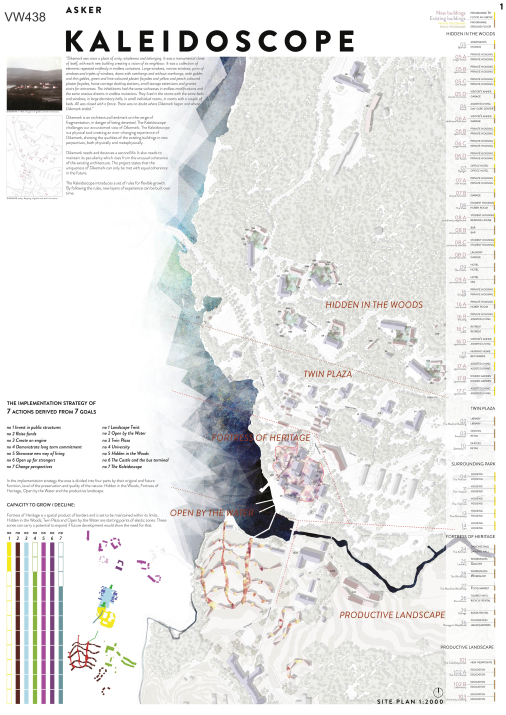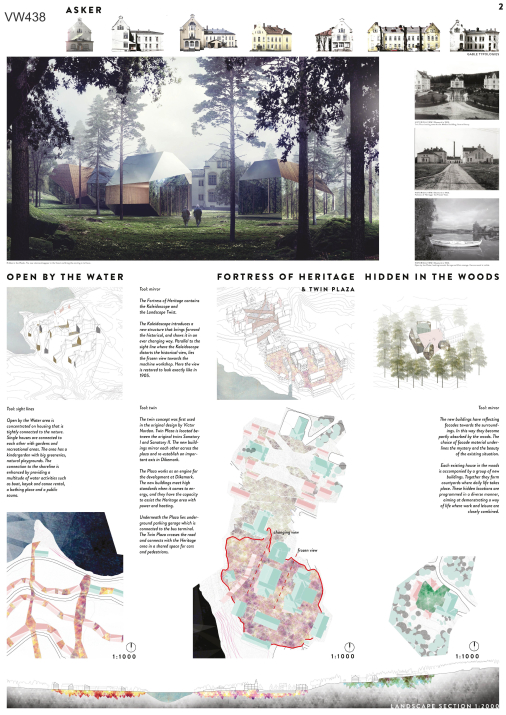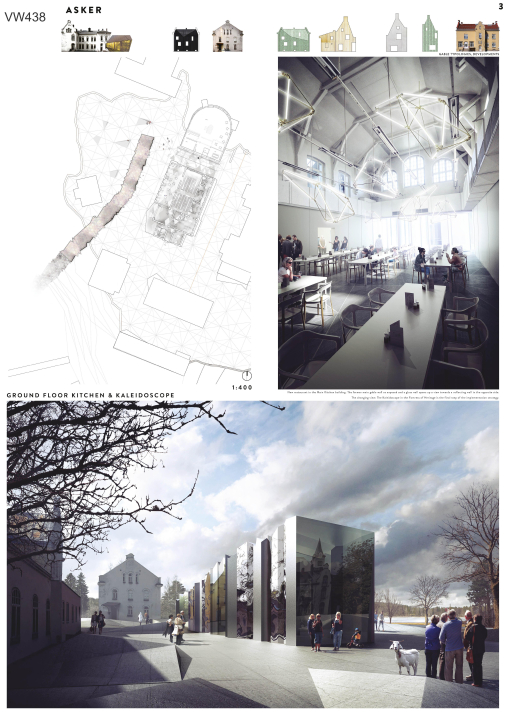Project:
Kaleidoscope
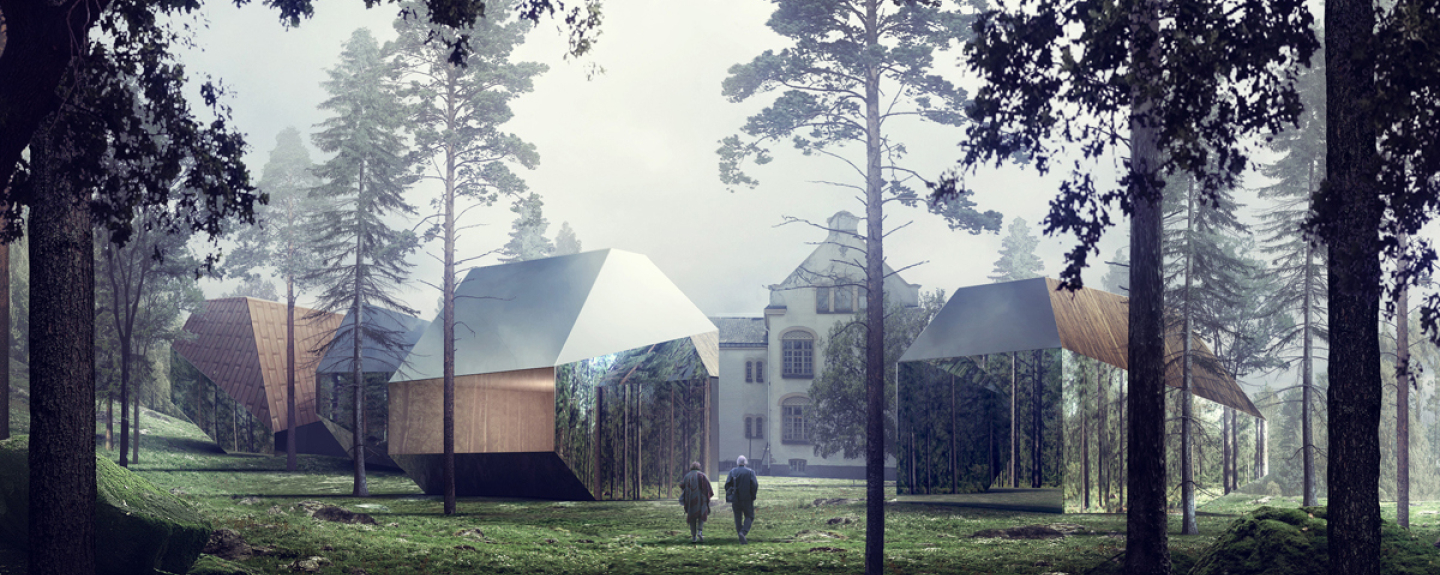
About
-
“Dikemark was once a place of unity, wholeness and belonging. It was a monumental clone of itself, with each new building creating a vision of its neighbour. It was a collection of elements repeated endlessly in endless variations. Large windows, narrow windows, pairs of windows and triples of windows, doors with overhangs and without overhangs, wide gables and thin gables, green and lime coloured plaster facades and yellow and peach coloured plaster facades, horse carriage docking stations, small storage extensions and granite stairs for entrances.
Dikemark is an architectural landmark on the verge of fragmentation, in danger of being deserted. The Kaleidoscope challenges our accustomed view of Dikemark. The Kaleidoscope is a physical tool creating an ever-changing experience of Dikemark, showing the qualities of the existing buildings in new perspectives, both physically and metaphysically.
Dikemark needs and deserves a second life. It also needs to maintain its peculiarity which rises from the unusual coherence of the existing architecture. The project states that the uniqueness of Dikemark can only be met with equal coherence in the future.
The Kaleidoscope introduces a set of rules for flexible growth. By following the rules, new layers of experience can be built over time.
The Implementation Strategy Of 7 Actions Derived From 7 Goals:
NO 1 Invest in public structures
NO 2 Raise funds
NO 3 Create an engine
NO 4 Demonstrate long term commitment
NO 5 Showcase new way of living
NO 6 Open up for strangers
NO 7 Change perspectivesNO 1 Landscape Twist
NO 2 Open by the Water
NO 3 Twin Plaza
NO 4 University
NO 5 Hidden in the Woods
NO 6 The Castle and the bus terminal
NO 7 The Kaleidoscope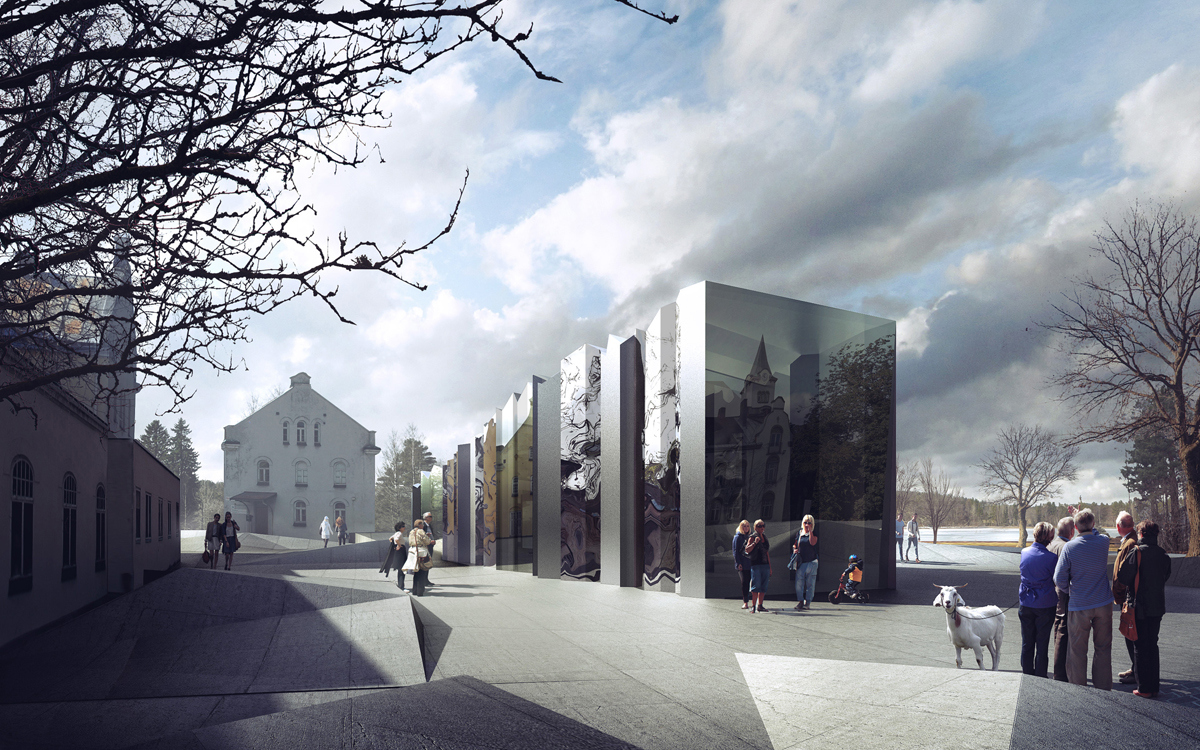
The Kaleidoscope proposes a seven-step strategy and a master plan to adapt the abandoned hospital at Dikemark for future life. The site’s capacity for growth is used as a driver to maintain the valuable characteristics of the area. The strategy is anchored in the master plan, through reprogramming the site and introducing funding methods. Variations in scale, program, privacy, ownership and degree of commitment are secured. To ensure continuation, the ownership structure is changed from singular to plural. The master plan is divided into four differentiated zones: Hidden in the Woods, Twin Plaza, Fortress of Heritage and Open by the Water. The Kaleidoscope as an overall design concept creates ever-changing perspectives, making a statement on the approach to built heritage.

-
This proposal gains distinction through a fine reading and understanding of the landscape as a driver, that gives identity and defines the area’s atmosphere and unity, but also enables very different relationships between building and landscape. Based on this approach four zones are defined – Hidden in the Woods , Twin Plaza, Fortress of Heritage and Open to the Water – reflecting different potentials and positions in the landscape and the existence of different building formations and spatial formations. Next to characterizing the existing build landscape these terms also present strategies and guiding principles for how to develop the four zones.
Through this synthesizing reading of the landscape and the appointment of the four zones an operational understanding of the existing built landscape is created, giving a sure and strategic foundation for the development and reinterpretation of the sub-areas.
The northernmost zone – Hidden in the Woods – covers an area with free-standing patient buildings. In this section a development-strategy is proposed, where the new buildings joins tightly around an existing building. This maintains the fundamental relationship between landscape and building: The extended conglomerate of buildings remains a point and a local densification in the landscape, handing over the main role to the forest.
The Fortress of Heritage and Twin Plaza – includes the central part of the existing buildings, with different service buildings organized in a more urban form, with square-like spaces. In this section a development strategy is proposed, providing an extended system of open spaces and passages, creating new connections and relationships to the water. There is hereby established a clear center – as demanded in the program – creating a neighborhood that offers spatial qualities and experiences differing from the small enclaves in the forest. However a greater density in this area must be developed to ensure a center-feeling, based on programmatic and spatial density. The very important relations to the water should also be further processed.
Open by the water is a new town by the sea in the transition to the agricultural landscape in the southernmost part of the competition-area. This new district is composed of semidetached houses and is to the east connected to a kind of experience-landscape, where there will be opportunities to get up close to nature’s processes and products. This southern settlement appears to be less convincing, both in its landscape position and in its structure and architecture.
But despite the weakness in the southern field the Kaleidoscope-project stands forward as a very convincing bid, because it is able to operate at a strategic level and at the same time present very clear structural and architectural principles, that will make the plan very flexible and robust, maintaining and enhancing the unique qualities of the landscape.
The jury is convinced that this methodological approach and clear principles based on an intelligent and enlightened reading of landscape, can ensure a high quality in the transformation of this area, which is expected to occur over a relatively long period.
-
Team Representative: Miia-Liina Tommila (FI) – architect; Associate: Emmi Juulia Keskisarja (FI), Silje Klepsvik (NO), Tone Megrunn Berge (NO) – architects
Contributors: Noora Aaltonen (FI) – architect; Vegard Aarseth (NO) – artist; Ossi Keskisarja (FI) – student in economics; Minnamarie Aleksandra Nurmi (FI) – writerOksasenkatu 1 b A 20, 00100 Helsinki – Suomi/Finland
+358 50 323 7534 – miialiina.tommila@gmail.com
T. M. Berge, S. Klepsvik, M.-L. Tommila and E. J. Keskisarja
Team interview
1. How did you form the team for the competition?
Three of the team members (Tommila, Klepsvik and Berge) knew each other from the studies at the Bergen School of Architecture. The two initiating members of the group (Tommila and Berge) worked a lot together before, but the geographical conditions changed since Miia-Liina Tommila moved back to Finland after graduation. The aim was to join the competition with a team that would not be set back by the geographical distance, first by finding team members who are interested in entering architectural work by associative methods and using a broad spectre of investigations to develop architecture. Silje Klepsvik was an obvious choice still living in Bergen and she was happy to join. Emmi Keskisarja came into our radar at an architectural book launch in Helsinki, and the match was made in heaven.
2. How do you define the main issue of your project, insisting on how you answered on this session main topic: adaptability and urban rhythms?
Dikemark is a unique environment, it has a strong character and it can withstand and even thrive on expansion if it is treated the right way. We take on the kaleidoscope glasses and look through them to try to see the heritage in a new way, to create ever-changing perspectives. We wanted to multiply Dikemark, see it in new angles and get more and more of Dikemark. This is what our architecture –represented by The Kaleidoscope– offers. The coherent built environment at Dikemark has been abandoned for a long time and has faced material neglect over many years. The challenge is to find the economical incentives to be able to restore Dikemark and accommodate new uses.
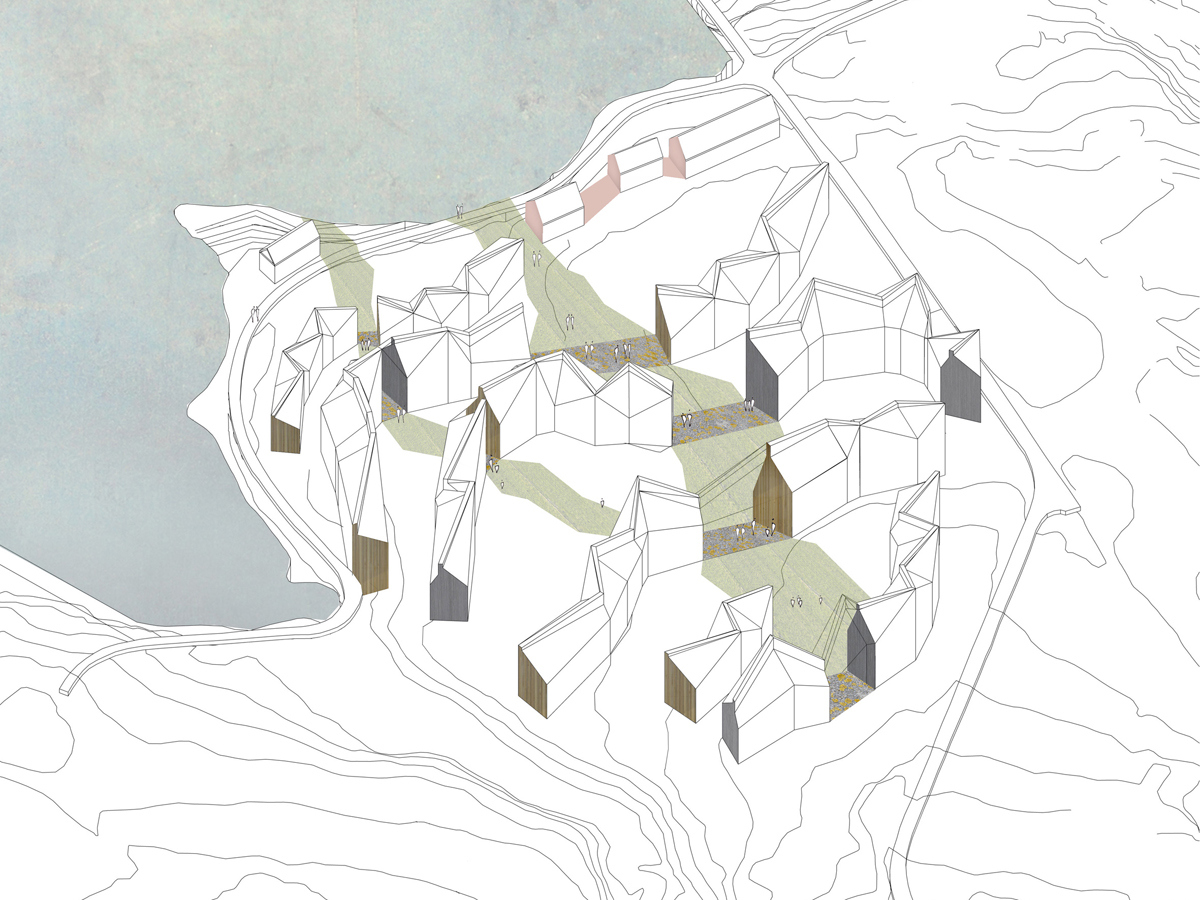
3. How did this issue and the questions raised by the site mutation meet?
The Kaleidoscope proposes a seven-step strategy and a master plan for adapting the abandoned mental hospital at Dikemark for future life. The site's capacity for growth is used as a driver to maintain the historically valuable characteristics of the area. The strategy is anchored in the master plan through key elements carefully fitted to reprogram the site and introduce means of financing the steps. The strategy secures variations in scale, program, privacy, ownership and degree of commitment.
4. Have you already treated this issue previously and could you present some reference projects that inspired yours?
We are tired of the polarized discussion about conservation strategies as a modern opposite or as subordinate copy. We wanted to propose an architectural answer that was as distinct in its character as the original design. It required a close reading of the landscape as well as familiarity with the original design. We organized the plan in four zones, where the relation to the landscape is fundamental for the involvement of the design itself. Our best reference is our architectural training: it is vital to be at the site to understand it fully. We have documented the site with 1500 photographs; we have categorized them in different ways to understand the potential at Dikemark.
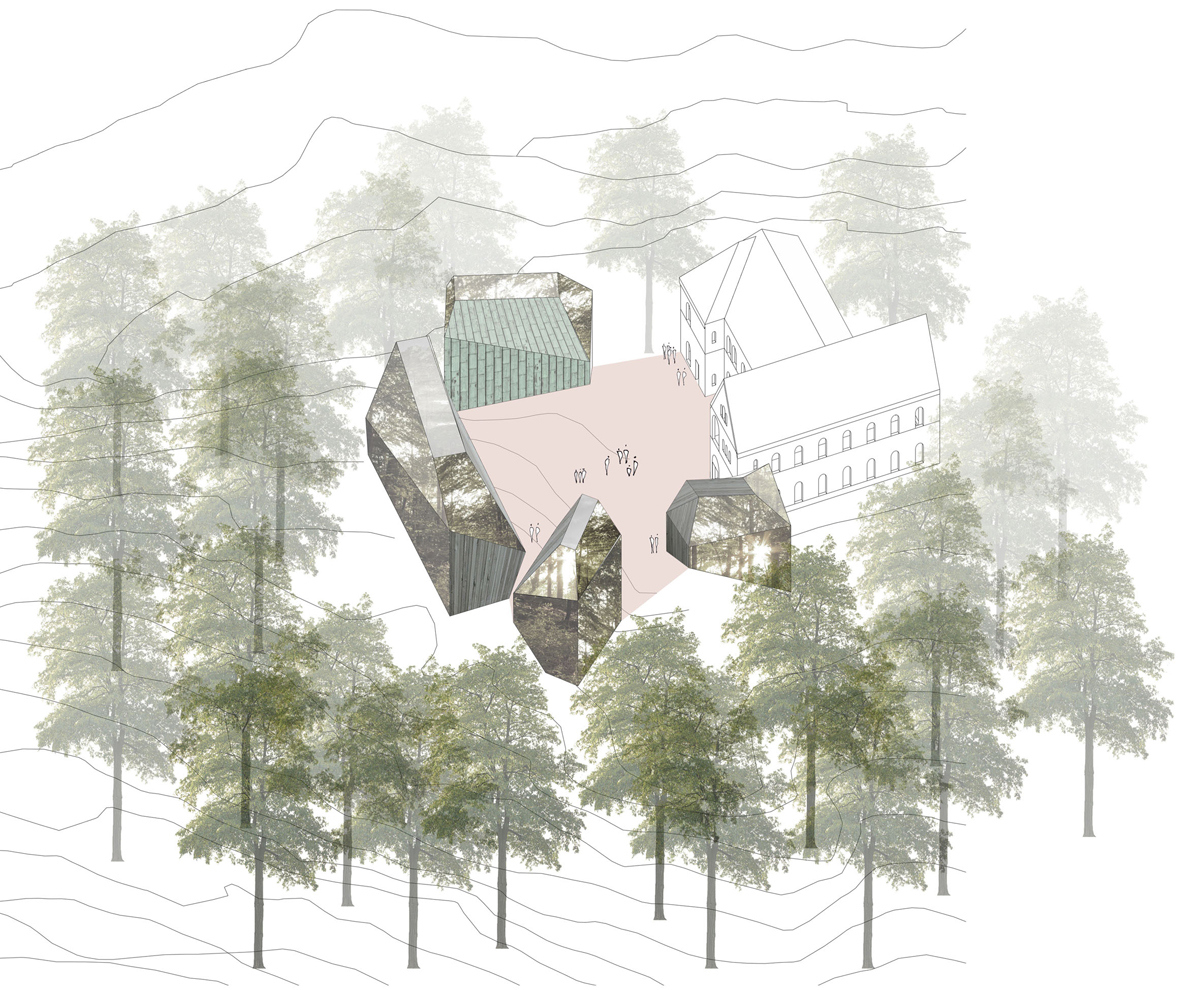
5. Today –within the era of an economic crisis and sustainability– the urban-architectural project should reconsider its production method in time; how did you integrate this issue in your project?
We approached the issue of economical and ecological efficiency both through the implementation strategy and the division of the site in four zones based on the level of preservation and natural qualities. Renovation of listed buildings is expensive. In order to collect necessary funds to renovate the whole area the project introduces different creative financial models. For instance, in the "Hidden in the Woods area" funds for the renovation are collected by building new houses around each old building. The old protected houses are not instantly changed into housing buildings because of the heavy building regulations. Phasing gives time for adaptation. It is important to develop the area with a pace that can sustain changes in ecological, economical and social climate.
6. Is it the first time you have been awarded a prize at Europan? How could this help you in your professional career?
This is the first time we have entered Europan and receiving an award is encouraging. The scope of this project is complex and we have worked with heart and mind and applied both associative knowledge and hard facts in order to produce a coherent result. It is really valuable to us that a competent jury and commissioners evaluated our work to be the best project for Dikemark.
People have asked us 'Who gets the ideas?' and 'How do you work the ideas out?'. Our method is the informed discussion, everyone owns every idea and is expected to spin further on whatever seems most fruitful at the time. Of course this means that a lot has to be dismissed at a later stage, and then we do not hesitate. The fact that we have worked out this project by this inclusive method is something we will take with us further. More directly we do pursue a concrete outcome of the competition entry and we are at the moment invited back to Asker to present the project at a public meeting and to discuss the process further.
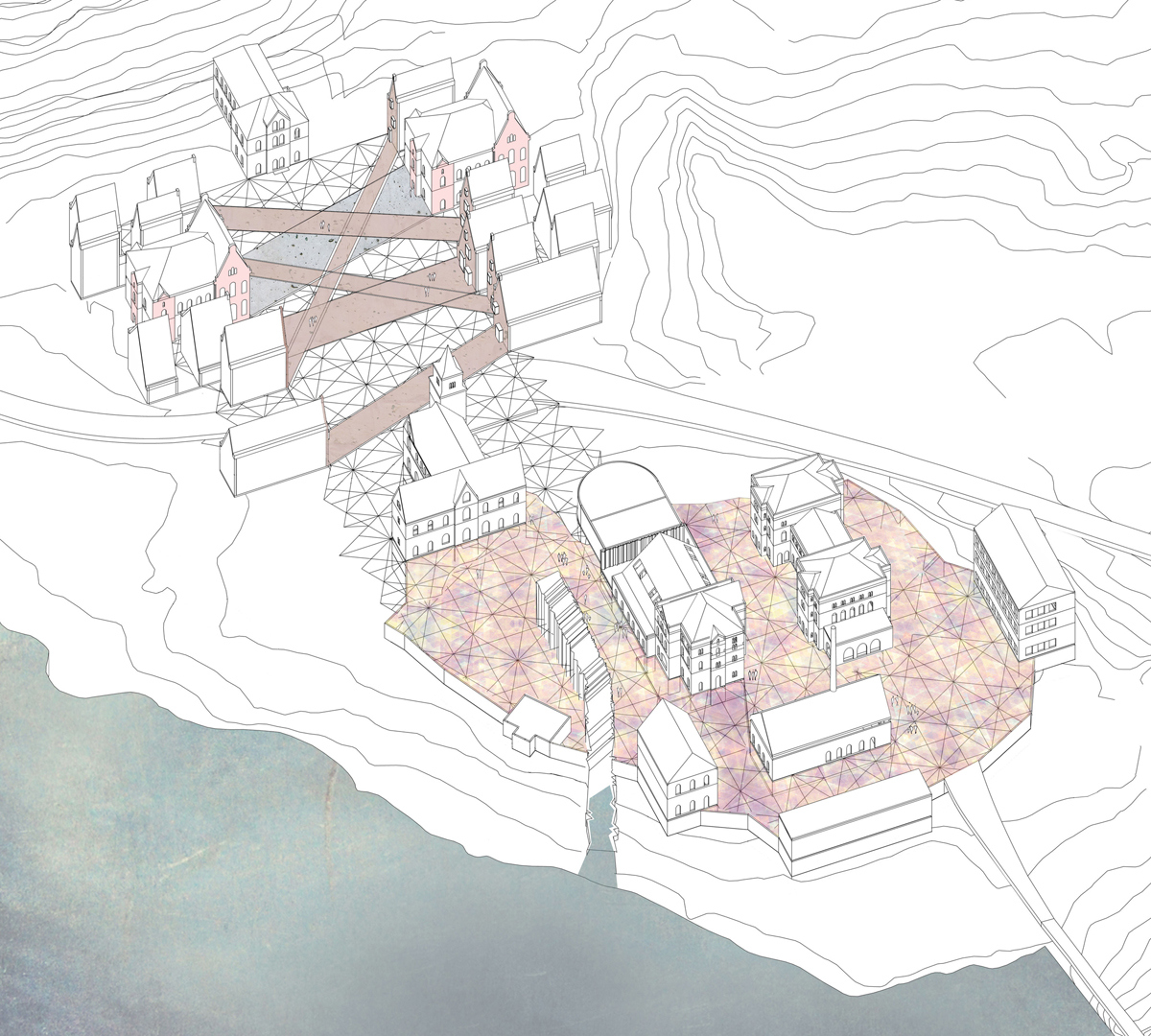
Related projects
-

Kaleidoscope
The Kaleidoscope introduces a set of rules for flexible growth. By following the rules, new layers…
-
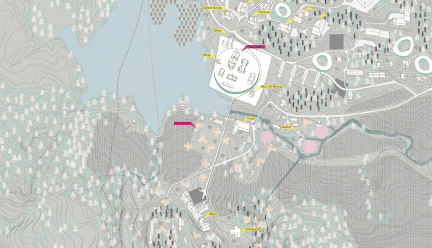
The Leaf
For ages the facades of this buildings were the edges of this enclave: to open them and give to the…
-
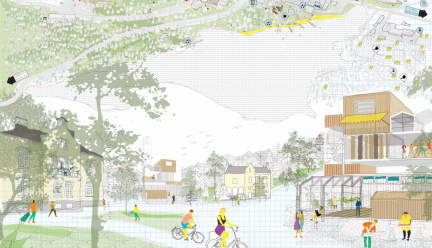
Ola K Asker
We propose a new self-sufficient city where tradition and technology co-exist. Inhabitants’…
